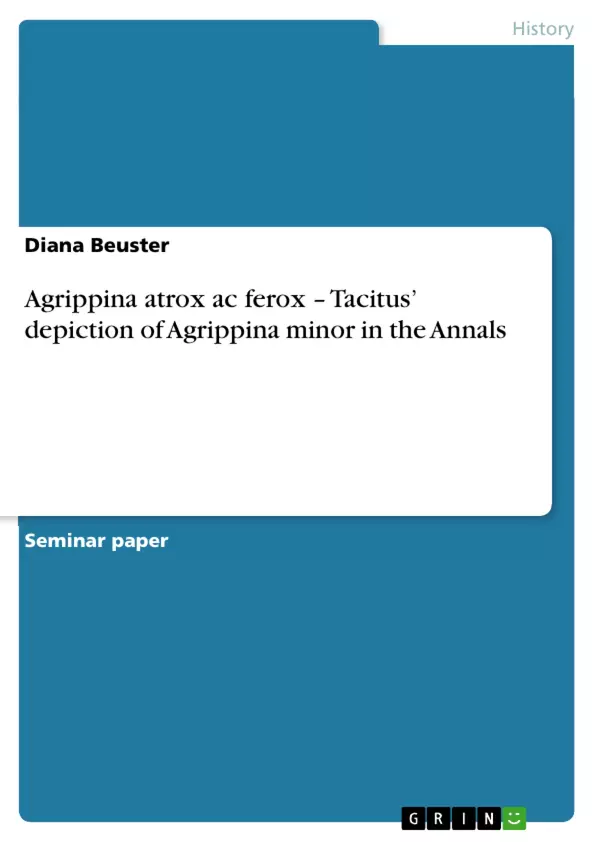Agrippina the younger seems to fascinate not only for modern authors or movie makers, but also ancient writers and artists. Not only was Agrippina minor widely used as model for statues or images on coins, she also used to play often a major role in the stories of ancient authors like Tacitus, Suetonius or Cassius Dio. She stands out in the description of those authors, characterized mainly as evil and greedy for power, interfering the businesses of the emperors and therefore totally un-female, if not even totally male in her character.
The paper covers biographical facts as well as Agrippina’s depiction in literary sources, her relations to the emperors of her family as well as her commemoration on coins. Furthermore, Agrippina’s actions, especially her political actions are described and the impact which they had on Roman society and on her characterization by Tacitus.
Inhaltsverzeichnis (Table of Contents)
- Agrippina atrox ac ferox - Tacitus' depiction of Agrippina minor in the Annals
- Early Life and Family Background
- Agrippina during Caligula's Reign
- Agrippina's Marriage to Claudius
- The Rise of Agrippina's Power
- Agrippina's Influence on Claudius
- Agrippina and the Adoption of Nero
- Agrippina's Honors and Public Recognition
Zielsetzung und Themenschwerpunkte (Objectives and Key Themes)
This work aims to provide a detailed analysis of Tacitus' depiction of Agrippina the Younger in the Annals, exploring her rise to power, influence, and her role in the early Roman Empire. The text focuses on examining how Tacitus portrays Agrippina as a powerful and ambitious woman, her relationship with the emperors Caligula and Claudius, and her influence on their reigns.- Tacitus' portrayal of Agrippina's ambition and political maneuvering
- The use of sexuality as a tool for power in ancient Rome
- Agrippina's relationship with the emperors Caligula and Claudius
- The changing role of women in the Roman Empire during the Julio-Claudian dynasty
- The historical context and political climate of the early Roman Empire
Zusammenfassung der Kapitel (Chapter Summaries)
- Agrippina atrox ac ferox - Tacitus' depiction of Agrippina minor in the Annals: This introductory chapter sets the stage for the analysis by providing a brief overview of Agrippina's life and the historical context of her life and reign. The chapter highlights Tacitus' negative portrayal of Agrippina as a ruthless and ambitious woman. It also establishes the key themes of the work, including Agrippina's rise to power, her influence on the emperors, and the use of sexuality as a political tool.
- Early Life and Family Background: This chapter explores Agrippina's early life and family background, emphasizing her connections to the ruling families of Rome and the opportunities they presented for her. It delves into her lineage, tracing her ancestry back to Augustus, and the impact of her family relationships on her future.
- Agrippina during Caligula's Reign: This chapter examines Agrippina's experiences during the reign of her brother, Caligula. It focuses on her initial rise in influence and the honors bestowed upon her, including her inclusion in oaths, her participation in games, and the depiction of her on coins. However, it also highlights the accusations of incest and Agrippina's eventual exile.
- Agrippina's Marriage to Claudius: This chapter focuses on Agrippina's marriage to Claudius, her uncle and the emperor after Caligula's assassination. It explores the political motivations behind the union and the benefits it brought to both Agrippina and Claudius. Tacitus' depiction of Agrippina's political schemes and her use of sexuality to achieve her goals are also discussed.
- The Rise of Agrippina's Power: This chapter analyzes Agrippina's growing influence over Claudius and her manipulation of the imperial court. It examines the various strategies she employed to consolidate her power, including her role in the adoption of her son, Nero, as Claudius' heir. The chapter also explores the symbolic implications of Agrippina's titles and her public recognition.
- Agrippina's Influence on Claudius: This chapter focuses on Agrippina's influence on Claudius' policies and decisions. It explores her impact on his reign, including the adoption of Nero and the bestowal of honors upon her. Tacitus' portrayal of Agrippina as a dominant and manipulative figure is also discussed.
- Agrippina and the Adoption of Nero: This chapter examines Agrippina's role in the adoption of her son, Nero, by Claudius. It explores the motivations behind the adoption, both for Agrippina and Claudius, and its consequences for the future of the Roman Empire. Tacitus' account of the events surrounding the adoption and Agrippina's influence on Claudius are also discussed.
- Agrippina's Honors and Public Recognition: This chapter explores the various honors and public recognition bestowed upon Agrippina, including the title Augusta, and her portrayal on coins. It analyzes the symbolic implications of these honors and their impact on the perception of Agrippina's power and influence. The chapter also discusses how these honors reflect the changing role of women in the Roman Empire.
Schlüsselwörter (Keywords)
This work explores themes of power, ambition, politics, and gender in ancient Rome. It focuses on the historical figure of Agrippina the Younger and her complex relationship with the emperors Caligula and Claudius. Key terms and concepts include: Agrippina the Younger, Tacitus, Annals, Roman Empire, Julio-Claudian dynasty, power, ambition, political maneuvering, sexuality, gender, emperor, empress, adoption, influence, honors, titles, Augusta, coins.- Arbeit zitieren
- M.A. Diana Beuster (Autor:in), 2008, Agrippina atrox ac ferox – Tacitus’ depiction of Agrippina minor in the Annals, München, GRIN Verlag, https://www.grin.com/document/128663



